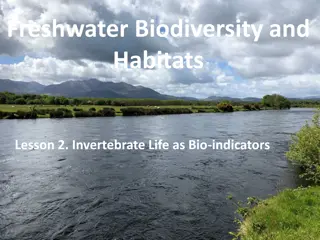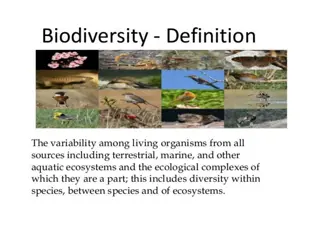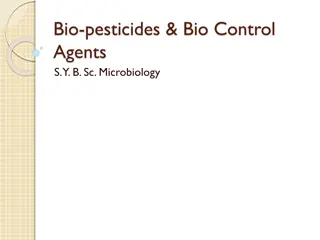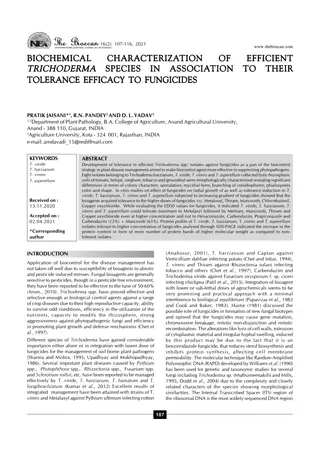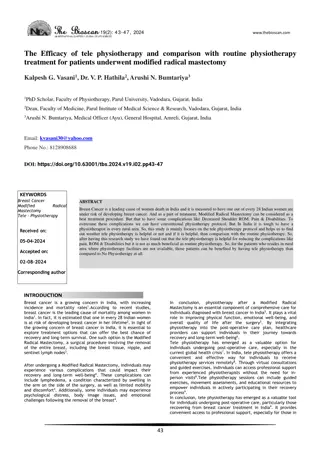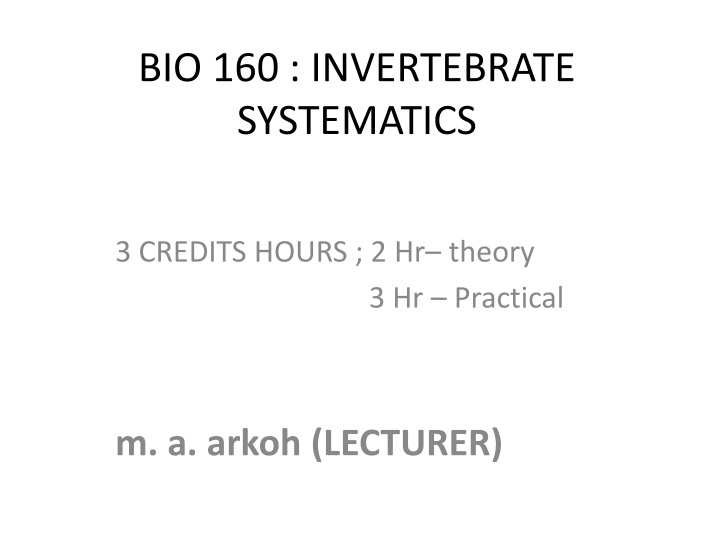
Invertebrate Systematics - Study of Biological Diversity and Relationships
Delve into the world of invertebrate systematics, exploring the diversity and inter-relationships of living organisms through time. This course covers the phylogenetics of invertebrates, taxonomy, and the classification of various sub-kingdoms within the animal kingdom. Understand the historical and modern patterns of biodiversity through comparative studies of living and fossil species. Explore the importance of systematics in understanding the origins and evolution of different organisms.
Download Presentation

Please find below an Image/Link to download the presentation.
The content on the website is provided AS IS for your information and personal use only. It may not be sold, licensed, or shared on other websites without obtaining consent from the author. If you encounter any issues during the download, it is possible that the publisher has removed the file from their server.
You are allowed to download the files provided on this website for personal or commercial use, subject to the condition that they are used lawfully. All files are the property of their respective owners.
The content on the website is provided AS IS for your information and personal use only. It may not be sold, licensed, or shared on other websites without obtaining consent from the author.
E N D
Presentation Transcript
BIO 160 : INVERTEBRATE SYSTEMATICS 3 CREDITS HOURS ; 2 Hr theory 3 Hr Practical m. a. arkoh (LECTURER)
COURSE OUTLINE SYSTEMATICS PHYLOGENETICS OF INVERTEBRATES INVERTEBRATE SYSTEMATICS 3 SUB-KINGDOMS :PROTozoa MESOZOA METAZOA *PROTISTA : SARCOMASTIGOPHORA, APICOMPL. *METAZOA : PARAZOA EUMATOZOA
3 EUMATOZOA : INVERTEBRATA & VERTEBRATA INVERTEBRATA : RADIATA & BILATERIA RADIATA : COELENTERATA CNIDARIA & CTENOPHORA BILATERIA : ACOELOMATA, PSEUDO- COELOMATA & COELOMATA ACOELOMATA : Platyhelminthes & Nimertini PSEUDO-COELOMATA : Nematoda & Aschelminthes COELOMATA : Annelida, Arthropoda & molluska
SYSTEMATICS Systematics is the branch of biology that deals with the diversity and inter-relationships of living things through time. It deals with both current organisms (neontology) and prehistoric ones (palaeontology) or (extinct and extant organisms). Systematics is therefore, the study of biological diversity and its origins.
5 It is therefore, the study of biodiversity and its historical and modern patterns and processes, which involves the comparative study of living and fossil species. Systematics thus, involves taxonomy and phylogenetic analysis. Phylogenetics is the science of reconstructing the evolutionary history of the organisms. It has two components, branching order (showing group relationships) and branch length (showing amount of evolution).
6 Systematics is achieved through 2 means; classification and taxanomy. classification focuses on placing organisms within hierarchical groups that show their relationships to other organisms. While taxonomy is specifically, the identification, description, and naming (nomenclature) of organisms. Earlier scientists, made use of plesiomorphies (ancestral traits) and apomorphies (derived traits) to understand systematics though, modern science use molecular biology and computer programs to study organisms.
Classification- major groupings OLD SYSTEM - Empire Kingdom - Kingdom Phylum - Class Class - Order Order - Genus Family - Species Genus - Variety Species There are other sub-groupings with regard to the number of varieties within a taxon; super, sub, etc. These were adopted by Linnaeus, Whittaker, etc. NEW SYSTEM
REFFERENCES Monger, G. & Sangster (1988). Systematics and classification. Kershaw, R.D(1983). Animal diversity. Pichenik, J.A (1996). Invertebrate Zoology Hickmann, Larsen & Roberts (2007). Animal diversity. Cleveland, Larry & Allan (2006). Animal biology. Purves, Orians & Heller (2000). Life (science of biology). Barnes, Callow & Goldwig (1998). The invertebrate www.wikipedia.org. www.goggle.com
LESSON 2 Generally, we will deal with the following classification ; KINGDOM: Animalia __________I ___________ I I Sub-K. Protozoa Mesozoa ______I ____ ______I____ I I Branch I I S.P. Sarco- Apicom- mastigophora plexa I I I Metazoa I Parazoa I I I I Radiata I Eumatozoa ______I____ I Bilateria I I
10 I I I I I I I I I I I I I I I I I I I I I I Acoe- Pseu- Coe- I loma- doCo- loma- I ta elomata I I _____I_______ I I ta I I Phy- 4 2 1 2 2 2 3 lum *Vertebrates and Chordates come under Coelomata. * Sarco-mastiphora has sarcodina, opalinata, Mastigophora, Cilliophora as Phyla
11 *Apicomplexa has 2 phyla; Sporozoa and Teleospora Under Metazoa, Super-phyla Radiata has 2 phyla; Cnidaria and Ctenophora. Super-phyla Bilateria has 3 types ; *Acoelomata has Platyhelminthes, Nimertini *Pseudo-Coelomata has Nematoda, Aschelminthes, *Coelomata has Annelida, Arthropoda, Molluska. Ps.There are others but they come under Vertebrata





